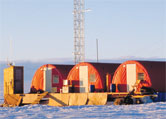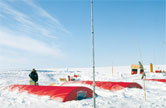Greenland's ice sheet real-time, real fast

The intimidating vastness of the Greenland Ice Sheet is a familiar backyard to CIRES Director Konrad Steffen. He has amassed more than 20 years of meteorological and glaciological data as part of the Greenland Climate Network, or GC-Net, a series of automated weather stations tracking changes in Arctic conditions.
The project stands poised to enter a new phase of research, providing more complete weather information to the World Meteorological Organization (WMO) in Geneva, and the Danish Meteorological Institute (see sidebar on p. 14). Already, the long-running and extensive datasets are revealing some surprising trends about the polar climate: Steffen and his colleagues have shown that polar regions are responding much faster to climate change than expected.
"Since 2000, Greenland's ice sheet has gone from losing 50 gigatons of ice per year to 250 a year," says Steffen. "That's two times all the ice in the European Alps."
This rapid response to warming is largely due to the ice sheet's albedo — the surface's ability to reflect light — says Steffen. Melting snow is not as bright as fresh snow, so it absorbs more energy and becomes warmer. The resulting darker meltwater also absorbs more light, so overall, more ice melts into water and runs into the ocean. By scientist's calculations, Greenland's ice loss (about half from melt, half from iceberg calving) accounts for about 30 percent of the global sea-level rise originating from ice.
Steffen expects the meltwater trend to continue in the coming years. "We were able to detect a two-degree–Celsius (almost four-degree-Fahrenheit) increase in mean temperature per decade at Swiss Camp, which is huge," says Steffen.
Current weather and climate models are not very good at picking up the increase in ice loss from melting and iceberg calving, but data collected by GC-Net are likely to help. Each of 18 stations currently active around


Swiss Camp on the Greenland Ice Sheet in 1990, and then during the snowy year of 1995. Natural variability imposes ups and downs in snow levels and temperatures, but overall, it's getting warmer.
the ice sheet collects a host of information, including temperature, humidity, wind velocity, solar and Earth radiation, and ice-sheet elevation, beamed back hourly via satellite to Steffen's office in Boulder, Colorado. The data ultimately become available to other researchers, and provide a high-resolution dataset to compare against regional models used to project future changes. "To understand changing seasons and forcing, we need higher-resolution data, which is provided by GC-Net."
Beaming data back by satellites requires a substantial effort: Steffen and his team travel once a year to Greenland to check on some of the stations personally. The researchers have endured white-out blizzards, rebuilt collapsed camps, and perfected their extreme environment electronic skills — all to bring back the data that's providing the most intimate view yet of Greenland's changing climate.
"It's worth it," says Steffen. "This kind of long-term monitoring in polar regions is crucial to understanding how the ice sheet is responding to rising temperatures and changes in precipitation."
This project is sponsored by NASA and the National Science Foundation.
